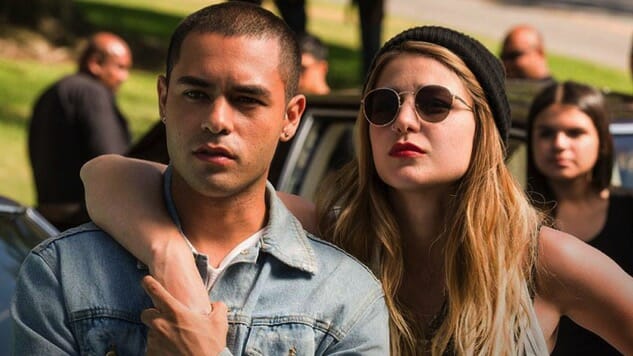In Lowriders, the Unnecessary White Love Interest Strikes Again

It’s always exciting when a film promises to offer intimacy with a world you’ve always been curious about or fascinated by. But when the film is centered on the cultural experiences of people of color, one must always remain a bit skeptical. Hollywood, after all, has a tendency to disappoint in the rendering of such stories. I’d hoped that Lowriders, being a somewhat under-the-radar film, and one starring and penned by all people of color would avoid some familiar trappings and—most importantly—introduce moviegoers to the Mexican-American art world of lowrider and vintage car customization, but such was not the case. In spite of some compelling performances and a strong premise, Lowriders falls short of greatness.
Let’s begin with an issue I’d hoped to not write about again so soon, after witnessing the unnecessary centering of the white gaze in HBO’s The Immortal Life of Henrietta Lacks. Lowriders certainly doesn’t make such an egregious error, as the story is firmly centered on Mexican-American protagonist Danny (played by Gabriel Chavarria) a talented graffiti artist whose father (Demián Bichir) runs a car shop that specializes in high-end, lowrider detailing. Complications in the family arise when Danny’s older brother (Ghost, played by a fairly captivating Theo Rossi) is released from prison and old, long-festering wounds reveal themselves.
Lowriders is ultimately a father/son(s) drama, and even the appearance of the white gaze can’t take away from that—but its appearance remains infuriating. As Danny sides with his brother and embraces the lowrider world through the work they start doing together (work that will put them in direct competition against their father), he falls in love with a hipster-ish white girl (Melissa Benoist as Lorelai), who also happens to be a photographer … which means we get the distinct displeasure of seeing his world through her lens, literally. The scenes that focus on the creation of these cars, and Danny’s incredible talent as a muralist are beautiful—the colors and energy of the work and its display in the streets and parking lots of LA captured well by director Ricardo de Montreuil. That so many of them are shown through the eyes of the white love interest is completely unnecessary and disappointing.
Unless of course, the intent was to challenge the white gaze itself, which is precisely what Lowriders pretends to do, during one of its most fascinating scenes. Lorelai introduces Danny to an even more hipster-ish, white local gallery owner, who is equally, annoyingly taken with the artwork. And Danny is rightfully offended when she tries to describe his work as representative of his family’s struggles as immigrants; Danny isn’t making political art, but his white girlfriend assumes that the only way to “sell” him to this white man is to politicize his work and attempt to badly deconstruct a social critique that isn’t actually there. It’s a brilliant moment that perfectly captures the violence of the white intellectual gaze, and it makes you wonder if that was the very purpose of Lorelai’s existence. It would have made for a great storyline, if Danny had seen Lorelai for her pimp-ish, exploitative ways and gone on about his business—perhaps in search of a lovely girl from his actual neighborhood who wouldn’t be so wide-eyed and impressed with his lifestyle—but Hollywood seems to be having an interracial relationship moment, so what do I know?
-

-

-

-

-

-

-

-

-

-

-

-

-

-

-

-

-

-

-

-

-

-

-

-

-

-

-

-

-

-

-

-

-

-

-

-

-

-

-

-








































